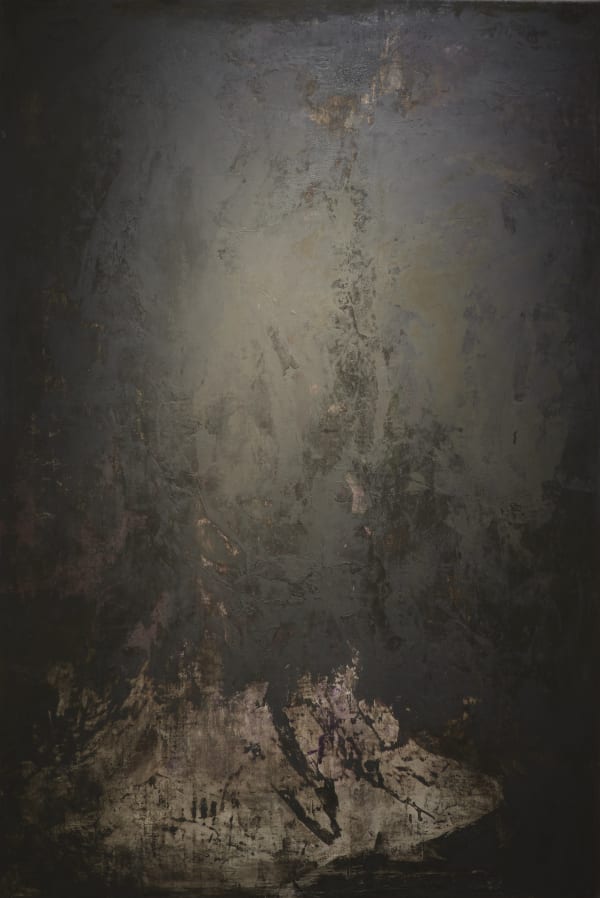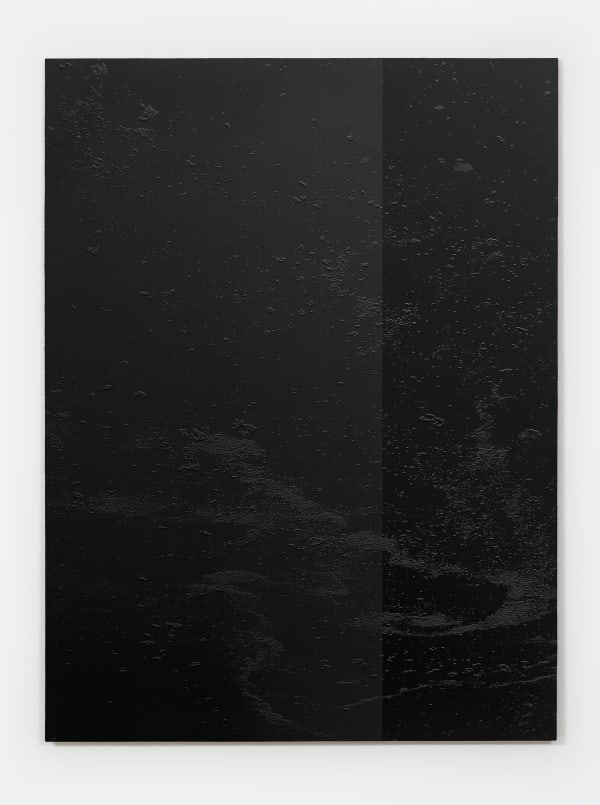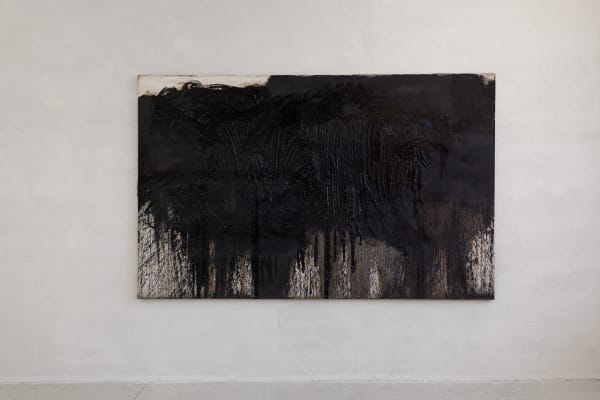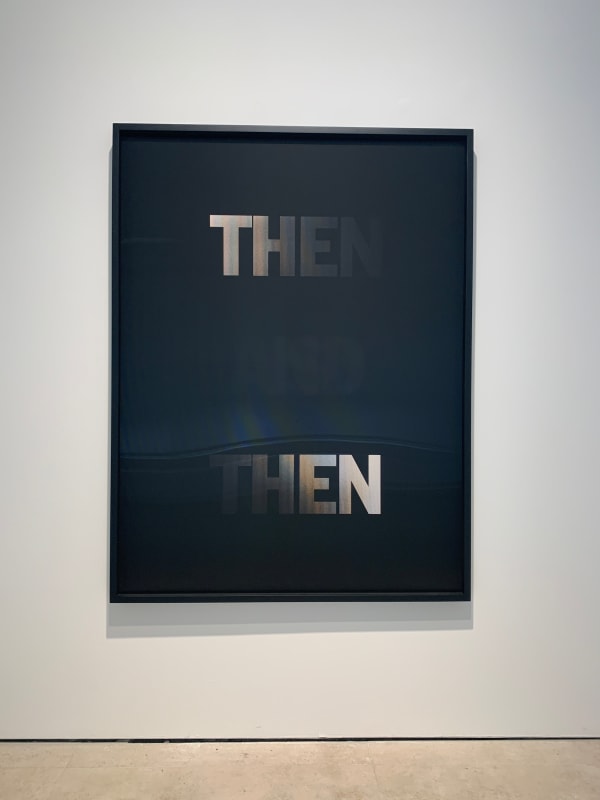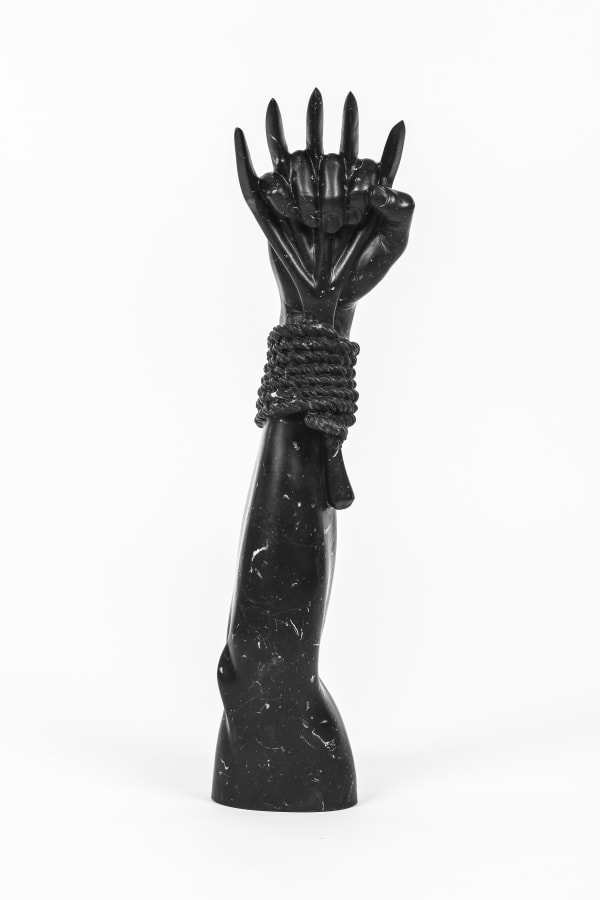Resistance
A refined selection of paintings and sculptures celebrating the power of an inspiring and highly symbolic colour: BLACK.
Often associated with witchcraft or mourning, from the 14th to the 16th century, black became a respectable and luxurious colour, related to royalty until the middle of the 17th century. Later, the black colour has been linked to modernity. As such the meaning of the black colour has evolved over the years and its significance is now pluri-vocal. It has become tragic, poetic, modern, elegant, and transgressive, often seen as a symbol of rebellion.
In the history of art, the colour blackevolved and became the subject matter and experimentation of many artists. As Henri Matisse said “Black is a colour by itself, which sums up and consumes the other colours.” In 1915, the Russian painter Kasimir Malevich presented his famous Black Cross and Black Square, initiating the movement of suprematism, which focused on basic geometric forms painted in a limited range of colours. The black in Malevich’s paintings, discharged of its symbolic substance, becomes a manifesto of modernity, marking a break in the history of art. Later, Abstract Expressionist artists such as Robert Motherwell and Franz Kline appropriated the black colour as their artistic language, exploring the materiality of the colour. The American sculptor Louise Nevelson, on her side, honoured the black colour through monumental, monochromatic, wooden wall pieces and outdoor sculptures made out of recycled objects. The black colour for her “wasn’t a negation of colour. It was an acceptance. Because black encompasses all colours. Black is the most aristocratic of all.”
In the sixties, the French painter Pierre Soulages created the concept of outrenoir, exclusively using the black colour to create black paintings that evolve in time and space through light. In opposition to the variety of nuances of black used by Soulages, the British artist Anish Kapoor bought the artistic rights of the Vantablack colour in 2016, a colour which defies the perception of space and materiality.
In the continuation of this historical introduction of the black colour, the exhibition Resistance celebrates the place of black in contemporary art, from drawings, to paintings, through photography and sculptures. The exhibition combines in an elegant way, creations that analyse the emotional, poetical, social and political impact of black pieces. Some inspire melancholy, some show us the expressionist power of this chromatic choice, others analyse the colour in a more conceptual/ironical way.
The show will put together works by: Radcliffe Bailey, Kwesi Botchway, Justin Brice, Stefan Brüggemann, Keith Haring, Lyle Ashton Harris, Bill Jensen, Rashid Johnson, Paul Kremer, Allan McCollum, Paul Morrison, Hermann Nitsch, Nathlie Provosty, Hiroshi Sugimoto, Hank Willis Thomas and Gavin Turk.
Crucial contemporary Afro-American artists like Rashid Johnson, Radcliffe Bailey, Lyle Ashton Harris and Hank Willis Thomas in MARUANI MERCIER's group exhibition gives a political dimension to the exhibition referring implicitly to the important socio-political campaign of ‘Black Lives Matter’.
The central piece of the show Resistance, a sculpture by Hank Willis Thomas, draws upon the history of the Leopard (Anyoto) Society, a secret society active from 1890-1935 across west Africa. Although it was a society established for political emancipation and empowerment as a way to circumvent colonialist rule, the Leopard Society is depicted by-and-large as violent, evil, and sexually promiscuous in popular culture and the Euro-centric imagination, which can be traced through the dissemination of the Tarzan stories, Tintin comic, Disney motion pictures, and beyond. By isolating the claw of the “leopard” individually, Thomas draws attention to its symbolism of power, unity, and community.
While some of the works presented in the exhibition have a political undertone, not only referring to socio-political matters but also responding to an environmental urgence, like Justin Brice’s abstract ocean views, other works focus on the aesthetic experience obtained by “monochromatic” black pieces.
Some inspire melancholy, like Hiroshi Sugimoto’s blurred photographs of architecture resisting time and erosion. Some show us the expressionist power of this chromatic choice: Hermann Nitsch’s monumental compositions, or Bill Jensen’s impressive mountains.
Others analyse the colour in a more conceptual/ironical way like Allan McCollum or Gavin Turk.
Using the colour black in an abstract style, Nathlie Provosty and Paul Kremer both incorporate geometric forms in their paintings. While Paul Kremer’s work is in a sense reminiscent of Ellsworth Kelly’s minimalist and Colour Field paintings, Nathalie Provosty’s monochromatic black paintings evolve with the appearance of light.
The exhibition is completed by the more playful works by Keith Haring and Paul Morrison. In a cartoon style, Keith Haring addresses social issues, advocating for AIDS awareness. Paul Morrison, on his side is known for methodical black and white landscape paintings and print.
Resistance explores the different possible interpretations and aesthetics of the black colour, inviting the viewer to reflect on the political, social and poetical meaning of the colour.
* Michel Pastoureau, Noir: Histoire d’une couleur, Le Seuil, 2008.
-
 Radcliffe BaileyMobile Bay 1959, 2019piano keys and wax123.5 x 90 x 20 cm
Radcliffe BaileyMobile Bay 1959, 2019piano keys and wax123.5 x 90 x 20 cm
48 9/16 x 35 6/16 x 7 13/16 in -
 Kwesi BotchwayHeaven, 2021oil on canvas80 x 80 cm
Kwesi BotchwayHeaven, 2021oil on canvas80 x 80 cm
31 1/2 x 31 1/2 in -
 Stefan BrüggemannHyper-Palimpsest, 2019acrylic and spray paint on wood205 x 120 x 5.5 cm
Stefan BrüggemannHyper-Palimpsest, 2019acrylic and spray paint on wood205 x 120 x 5.5 cm
80 3/4 x 47 1/4 x 2 1/8 in
ref : BRUGG95546 -
 Keith HaringUntitled, 1988sumi ink on paper73 x 102 cm
Keith HaringUntitled, 1988sumi ink on paper73 x 102 cm
28 11/16 x 40 2/16 in
framed: 89 x 118 x 4 cm -
 Lyle Ashton HarrisNyame Bekyere, 2019Unique assemblage (Ghanaian cloth two-dye sublimation prints artist’s ephemera)103.1748 x 126.365 cm
Lyle Ashton HarrisNyame Bekyere, 2019Unique assemblage (Ghanaian cloth two-dye sublimation prints artist’s ephemera)103.1748 x 126.365 cm
40 9/16 x 49 3/4 in
Framing Dimensions: 103.17 x 126.36 x 6.35 cm -
 Bill JensenEND OF THE ORDINARY REALM (HUANGSHAN MOUNTAIN), 2013-14oil on linen155 x 104 cm
Bill JensenEND OF THE ORDINARY REALM (HUANGSHAN MOUNTAIN), 2013-14oil on linen155 x 104 cm
61 1/16 x 40 15/16 in -
 Rashid JohnsonCosmic Slop Little Brother, 2012black soap microcrystalline wax on board183 x 122 x 4 cm
Rashid JohnsonCosmic Slop Little Brother, 2012black soap microcrystalline wax on board183 x 122 x 4 cm
72 1/16 x 48 1/16 x 1 9/16 in -
 Justin BriceArctic Ocean III, 2019acrylic carbon black gesso linen aluminum panel201.3 x 151.1 x 1.9 cm
Justin BriceArctic Ocean III, 2019acrylic carbon black gesso linen aluminum panel201.3 x 151.1 x 1.9 cm
79 4/16 x 59 7/16 x 0 11/16 in -
 Justin BriceFram Strait Triptych, 2014/2017acrylic carbon black gesso linen aluminum panel101.6 x 76.2 x 1.52 cm
Justin BriceFram Strait Triptych, 2014/2017acrylic carbon black gesso linen aluminum panel101.6 x 76.2 x 1.52 cm
40 x 30 x 0 9/16 in
3 panels each : 101,6 x 76,2 x 1,52 cm -
 Paul KremerPinch02, 2021acrylic on canvas182.9 x 137.2 cm
Paul KremerPinch02, 2021acrylic on canvas182.9 x 137.2 cm
72 x 54 in -
 Allan McCollumThree individual "Plaster Surrogates", 1984enamel on cast hydrocal plaster in three partsa) 21.6 x 16.5 x 2 cm I 8.5 x 6.3 x 0.7 in
Allan McCollumThree individual "Plaster Surrogates", 1984enamel on cast hydrocal plaster in three partsa) 21.6 x 16.5 x 2 cm I 8.5 x 6.3 x 0.7 in
b) 15.2 x 12.7 x 2 cm I 5.9 x 4.7 x 0.7 in
c) 15.2 x 10 x 2.2 cm I 5.9 x 3.9 x 0.8 in -
 Paul MorrisonNight Mist, 2014acrylic on canvas38 x 50.5 x 3.5 cm
Paul MorrisonNight Mist, 2014acrylic on canvas38 x 50.5 x 3.5 cm
14 15/16 x 19 14/16 x 1 6/16 in -
 Hermann NitschRov_53_97, 1997acrylic on canvas188 x 300 cm
Hermann NitschRov_53_97, 1997acrylic on canvas188 x 300 cm
74 1/8 x 118 1/8 in -
 Nathlie ProvostyValence Violence Violets, 2018oil on canvasDiptych : overall: 213 x 238,5 x 2 cm
Nathlie ProvostyValence Violence Violets, 2018oil on canvasDiptych : overall: 213 x 238,5 x 2 cm
each panel : 213 x 116.8 x 2 cm -
 Hiroshi SugimotoChiesa Rossa, 1998Gelatin silver print in artist’s frame148.5 x 119 cm
Hiroshi SugimotoChiesa Rossa, 1998Gelatin silver print in artist’s frame148.5 x 119 cm
58 7/16 x 46 13/16 in
framed: 182.5 x 152.5 x 7.5 cm -
 Hank Willis ThomasNow and Then / Then is Now, 2017lenticular144.78 x 109.22 cm
Hank Willis ThomasNow and Then / Then is Now, 2017lenticular144.78 x 109.22 cm
57 x 43 in
framing dimensions : 147,5 x 112,5 x 4,6 cm -
 Hank Willis Thomas, Resistance in Black, 2021
Hank Willis Thomas, Resistance in Black, 2021 -
 Gavin TurkAlchemical Egg, 2018Chalk and blackboard paint on canvas80 x 60 x 2 cm
Gavin TurkAlchemical Egg, 2018Chalk and blackboard paint on canvas80 x 60 x 2 cm
31 7/16 x 23 9/16 x 0 12/16 in -
 Gavin TurkBlack Senza Titolo, 2012o on linen61.5 x 61.5 x 3.3 cm
Gavin TurkBlack Senza Titolo, 2012o on linen61.5 x 61.5 x 3.3 cm
24 3/16 x 24 3/16 x 1 4/16 in -
 Gavin TurkPistoletto’s Bags, 2018screenprint on mirror finished stainless steel244 x 122 cm
Gavin TurkPistoletto’s Bags, 2018screenprint on mirror finished stainless steel244 x 122 cm
96 1/16 x 48 1/16 in -
 Gavin TurkOvum Black Umber, 2019bronze58 x 58 x 80 cm
Gavin TurkOvum Black Umber, 2019bronze58 x 58 x 80 cm
22 13/16 x 22 13/16 x 31 7/16 in







